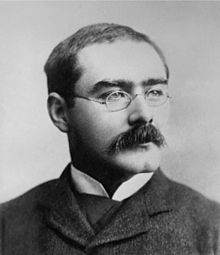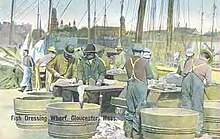Captains Courageous
Captains Courageous is a novel by the English writer Rudyard Kipling , published in London and New York in 1897 . As a series, however, the novel appeared in McClure's Magazine from November 1896 . The first German translation by F. Lavand was made in 1902 under the title Brave Seeleute , the second translation into German by N. Jacques in 1930 was titled Fischerjungs . The adventure story is one of the educational novels and has seen multiple adaptations in film, on stage and in literature.
The title itself is based on the introductory line of the ballad Mary Ambree : "When captains courageous, whom death could not daunt." Kipling had already used the quote on November 23, 1892 for an article in The Times about industrialists who, for him, were the new adventurers in his time.
content
The 15-year-old son of a self-made man millionaire, Harvey Cheyne Jr., is rightly seen as poorly brought up and effeminate. While crossing the Atlantic , it falls overboard in a violent storm. Just in time, he is rescued by the Portuguese fisherman Manuel, who belongs to the crew of the schooner We're Here from Gloucester . The boy tells the captain of the schooner , Disko Troop, about his origins and his wealth, and demands a return to the North American mainland. However, the captain and the seamen do not believe in his father's wealth and even if they did, they would shy away from returning, as otherwise they would lose valuable time fishing in the summer season.
Inevitably, Harvey has to come to terms with the situation and, as an additional cabin boy, earn board and lodging through hard physical work. Slowly he learned the basics of fishing in the vicinity of the Newfoundland Bank and won the respect and finally the friendship of the crew. In particular, Harvey Cheyne befriends Dan, the captain's son. Thus, in the course of time, the spoiled millionaire's offspring gradually turns into a tough young adult who is used to self-discipline.
When Harvey, long believed dead, returns to Gloucester after months of adventures at sea , his father, the railroad tycoon, is doubly happy: his son has finally undergone the change he had hoped for and in future will no longer judge his fellow human beings based on their origins and wealth , but primarily according to their skills. His father, Harvey Cheyne senior, expresses his gratitude by hiring Dan on one of his tea clippers and helping to finance his training to become a captain .
background
Kipling himself had started work on the novel in early February 1896 when he and his wife lived in Naulakha , Vermont . The resident physician James Conland had told him in detail about his youth on a schooner on the Newfoundland banks, which may have given the subject matter of the work. In any case, on February 11, Caroline Kipling noted that Captains Courageous would "take shape".
As a result, Kipling did extensive research on New England's fishing fleets . On February 18, he asked Washington attorney William Hallett Phillips to send him statistics and other material on the Great Banks. The couple visited the fishing ports in Boston and Gloucester to study the ships, docks, and tools. At Kipling's request, the doctor Conland had to cut up a cod in the traditional fishermen's way in order to familiarize him with the anatomy on the one hand and the working process on the other.
In August 1896, Kipling again visited Gloucester to see the memorial there, which had been erected for the men of the cod fishing fleet who had died at sea. Because of this preparatory work, Kipling often had to defend himself later from the judgment that he had written a report . So he replied: “ I wanted to see if I could catch and hold something of a rather beautiful localized American atmosphere that was already beginning to fade. Thanks to Conland I came near this. ”-“ I wanted to see if I could capture and hold the rather beautiful American atmosphere that was already disappearing. A thank you to Conland for getting close to it. "
Interpretation and classification
Captains Courageous. A Story of the Grand Banks can be described as an educational novel of the Victorian Age : “Physical hardening, self-control and a willingness to learn to obey and take the occasional beating - these were the requirements, in the opinion of Kipling and the defenders of the Victorian tradition, below those Boys become men. "
The novel, which was extremely popular with younger readers at the time of its creation, is free of the usual sentimentality of its time and tells an exciting story with realistic descriptions. The fishing techniques of that time are listed in detail. At first, American critics unanimously criticized the alleged slackening of Kipling's style in this novel, but Kipling returned the favor with a telling reprise of the pleonastic style of his critics, because he knew very well that he had changed his style due to his preparatory work.
Rudyard Kipling's dynamic style is clearly influenced by similar stories from Robert Louis Stevenson . However, in contrast to him, Kipling streamlines the narrative to the essential core. Unlike Herman Melville , whose Moby Dick Kipling was not to take note of as school reading until around 1903, and Joseph Conrad , whose story The Nigger of the Narcissus appeared less than a year later, Kipling was not a former seaman, but a professional author who found himself in had to empathize with the maritime world thanks to his research. He himself saw this work as a tribute to Mark Twain, whom he admired .
expenditure

- Captains Courageous. A Story of the Grand Banks. London 1897.
- Captains Courageous. A Story of the Grand Banks. New York 1897.
- In: Edition de Luxe. The Writings in Prose and Verse. 38 volumes. 1897-1938, Volume 12, London 1898.
- In: Bomby Edition. 31 vols., 1913-1938, volume 10, London 1913.
- In: Complete Works. Sussex Edition. 35 volumes. Volume 20, London 1937-1939.
- Captains Courageous. A Story of the Grand Banks. London 1950.
- Captains Courageous. A Story of the Grand Banks. New York 1959.
- Captains Courageous. A Story of the Grand Banks. New York 1970.
- Captains Courageous. A Story of the Grand Banks. London 1982.
- Captains Courageous. A Story of the Grand Banks. Bantam, New York 1985.
Translations:
- Good sailors. Translation into German by F. Lavand, Berlin 1902.
-
Fishing boys. Translation into German by N. Jacques, Leipzig 1930.
- after this last-mentioned new translation under the title Fischerjungs also in the complete work edition, edited by J. Gottwald. Volume 3. Munich 1965, 1976 and reprint 1978.
- Overboard , newly translated and edited by Gisbert Haefs. Mare, Hamburg 2007, ISBN 978-3-86648-072-8 .
Adaptations
Captains Courageous was filmed three times:
- 1937 as Captains Courageous , produced by Louis D. Lighton , directed by Victor Fleming . Cast includes Spencer Tracy , Freddie Bartholomew , Lionel Barrymore , Melvyn Douglas , Mickey Rooney and John Carradine . Tracy won the Academy Award for Best Actor for his acting performance. The film was a box-office hit and was nominated for three other Academy Awards. However, Fleming and the screenwriters Marc Connelly , John Lee Mahin and Dale Van Every had changed the basic story decisively: Here it was the fisherman Manuel and not the captain Disco Troop who significantly determined the upbringing of the boy. Also, unlike in the book, the character of Manuel was left to die when he was protecting the boy. The film thus followed the sentimental line that Kipling tried to avoid.
- 1977 as a television adaptation directed by Harvey Hart and with the actors Karl Malden (Troop), Ricardo Montalbán (Manuel), Fritz Weaver , Fred Gwynne and Neville Brand . This film adaptation was less thrilling than the one forty years before, but it had the advantage of being faithful to the original.
- 1996 also as a television film, director: Michael Anderson , actors: Robert Urich , Kenny Vadas , Kaj-Erik Eriksen , Sandra Nelson and Colin Cunningham .
Musical:
- Captains Courageous, The Musical , 1999. Off-Broadway production at the Manhattan Theater Club .
Literature:
- The trillion dollars Boy by Charles Sheffield tells the story of Captains Courageous in a futuristic world of science fiction to
literature
- Jêrome von Gebsattel: Captains Courageous. A Story of the Grand Banks. In: Major works of English literature. Individual presentations and interpretations . Volume 1: From the Beginnings to the End of the Victorian Age . Compiled by Henning Thies. Kindler Verlag, Munich 1995, ISBN 3-463-40271-8 , p. 214.
Web links
- Leonee Ormond: “Captains Courageous” - Introduction . kipling.org.uk; Retrieved October 23, 2012.
- Note on the text at Kipling Org
- Captains Courageous, The Musical. In: The Internet Off Broadway Database.
Individual evidence
- ↑ Explanations of titles. kipling.org.uk; Retrieved October 8, 2012.
- ↑ kipling.org.uk
- ^ Norman Page: A Kipling Chronology. Macmillan & Co., London 1984.
- ↑ Thomas Pinney (Ed.): Letters of Rudyard Kipling: (Vol. II) 1890-99. Macmillan, London 1990, p. 240.
- ^ Rudyard Kipling: Something of Myself. Edited by Thomas Pinney, Cambridge University Press 1995, p. 131.
- ^ Jêrome von Gebsattel: Captains Courageous. A Story of the Grand Banks. In: Major works of English literature. Individual presentations and interpretations . Volume 1: From the Beginnings to the End of the Victorian Age . Compiled by Henning Thies. Kindler Verlag, Munich 1995, ISBN 3-463-40271-8 , p. 214.
- ^ Atlantic Monthly , LXXX December 1897, pp. 856 f.
- ↑ Thomas Pinney (ed.): Letters of Rudyard Kipling: (Vol. II) 1890-99, Macmillan, London 1990, p. 323.
- ↑ Leonee Ormond: "Captains Courageous" - Introduction . kipling.org.uk; Retrieved October 23, 2012.



